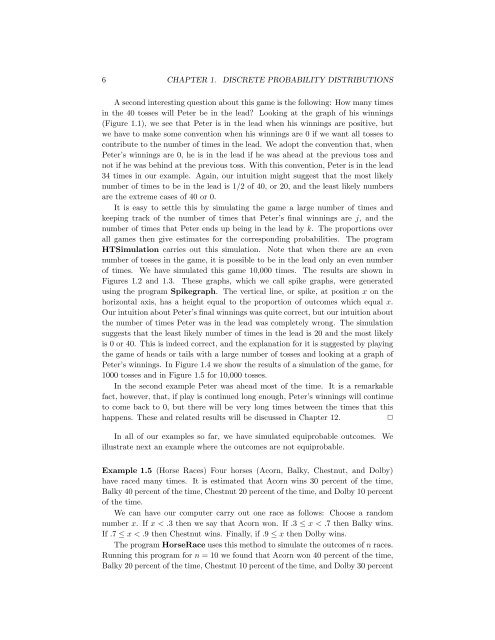Chapter 1 Discrete Probability Distributions - DIM
Chapter 1 Discrete Probability Distributions - DIM
Chapter 1 Discrete Probability Distributions - DIM
- No tags were found...
Create successful ePaper yourself
Turn your PDF publications into a flip-book with our unique Google optimized e-Paper software.
6 CHAPTER 1. DISCRETE PROBABILITY DISTRIBUTIONSA second interesting question about this game is the following: How many timesin the 40 tosses will Peter be in the lead? Looking at the graph of his winnings(Figure 1.1), we see that Peter is in the lead when his winnings are positive, butwe have to make some convention when his winnings are 0 if we want all tosses tocontribute to the number of times in the lead. We adopt the convention that, whenPeter’s winnings are 0, he is in the lead if he was ahead at the previous toss andnot if he was behind at the previous toss. With this convention, Peter is in the lead34 times in our example. Again, our intuition might suggest that the most likelynumber of times to be in the lead is 1/2 of 40, or 20, and the least likely numbersare the extreme cases of 40 or 0.It is easy to settle this by simulating the game a large number of times andkeeping track of the number of times that Peter’s final winnings are j, and thenumber of times that Peter ends up being in the lead by k. The proportions overall games then give estimates for the corresponding probabilities. The programHTSimulation carries out this simulation. Note that when there are an evennumber of tosses in the game, it is possible to be in the lead only an even numberof times. We have simulated this game 10,000 times. The results are shown inFigures 1.2 and 1.3. These graphs, which we call spike graphs, were generatedusing the program Spikegraph. The vertical line, or spike, at position x on thehorizontal axis, has a height equal to the proportion of outcomes which equal x.Our intuition about Peter’s final winnings was quite correct, but our intuition aboutthe number of times Peter was in the lead was completely wrong. The simulationsuggests that the least likely number of times in the lead is 20 and the most likelyis 0 or 40. This is indeed correct, and the explanation for it is suggested by playingthe game of heads or tails with a large number of tosses and looking at a graph ofPeter’s winnings. In Figure 1.4 we show the results of a simulation of the game, for1000 tosses and in Figure 1.5 for 10,000 tosses.In the second example Peter was ahead most of the time. It is a remarkablefact, however, that, if play is continued long enough, Peter’s winnings will continueto come back to 0, but there will be very long times between the times that thishappens. These and related results will be discussed in <strong>Chapter</strong> 12.✷In all of our examples so far, we have simulated equiprobable outcomes. Weillustrate next an example where the outcomes are not equiprobable.Example 1.5 (Horse Races) Four horses (Acorn, Balky, Chestnut, and Dolby)have raced many times. It is estimated that Acorn wins 30 percent of the time,Balky 40 percent of the time, Chestnut 20 percent of the time, and Dolby 10 percentof the time.We can have our computer carry out one race as follows: Choose a randomnumber x. If x
















